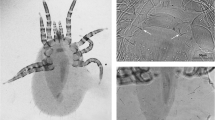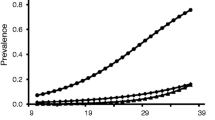Abstract
The poultry red mite, Dermanyssus gallinae, is currently a significant pest in the poultry industry in Europe. Biological control by the introduction of predatory mites is one of the various options for controlling poultry red mites. Here, we present the first results of an attempt to identify potential predators by surveying the mite fauna of European starling (Sturnus vulgaris) nests, by assessing their ability to feed on poultry red mites and by testing for their inability to extract blood from bird hosts, i.e., newly hatched, young starlings and chickens. Two genuine predators of poultry red mites are identified: Hypoaspis aculeifer and Androlaelaps casalis. A review of the literature shows that some authors suspected the latter species to parasitize on the blood of birds and mammals, but they did not provide experimental evidence for these feeding habits and/or overlooked published evidence showing the reverse. We advocate careful analysis of the trophic structure of arthropods inhabiting bird nests as a basis for identifying candidate predators for control of poultry red mites.
Access this chapter
Tax calculation will be finalised at checkout
Purchases are for personal use only
Preview
Unable to display preview. Download preview PDF.
Similar content being viewed by others
References
Abo-Taka SM (1996) Mites inhabiting poultry farms in Egypt. In: Mitchell R, Horn DJ, Needham GR, Welbourn WC (eds) Acarology IX, proceedings, vol 1. Ohio Biological Survey, Columbus, pp 97–99
Axtell RC, Arends JJ (1990) Ecology and management of arthropods pests of poultry. Annu Rev Entomol 35:101–126. doi:10.1146/annurev.en.35.010190.000533
Barker PS (1968) Bionomics of Androlaelaps casalis (Berlese) (Acarina: Laelapidae), a predator of mite pests of stored cereals. Can J Zool 46:1099–1102. doi:10.1139/z68-157
Beck W (1999) Farm animals as disease vectors of parasitic epizoonoses and zoophilic dermatophytes and their importance in dermatology. Hautarzt 50:621–628. doi:10.1007/s001050050971
Bloszyk J, Gwiazdowicz DJ, Bajerlein D, Halliday RB (2005) Nests of the white stork Ciconia ciconia (L.) as a habitat for mesostigmatic mites (Acari, Mesostigmata). Acta Parasitol 50(2):171–175
Brady J (1970a) The mites of poultry litter: observations on the bionomics of common species, with a species list for England and Wales. J Appl Ecol 7:331–348. doi:10.2307/2401384
Brady J (1970b) Litter mites and their effects on poultry. Worlds Poult Sci J 26:658–668. doi:10.1079/WPS19700022
Brouwer L, Komdeur J (2004) Green nesting material has a function in mate attraction in the European starling. Anim Behav 67:539–548. doi:10.1016/j.anbehav.2003.07.005
Buffoni G, Di Cola G, Baumgärtner J, Maurer V (1995) A mathematical model for trophic interactions in an acarine predator–prey system. J Biol Syst 3:303–312. doi:10.1142/S0218339095000289
Buffoni G, Di Cola G, Baumgärtner J, Maurer V (1997) The local dynamics of acarine predator-prey (Cheyletus eruditus–Dermanyssus gallinae) populations: identification of a lumped parameter model. Mitt Schweiz Entomol Ges 70:345–359
Burtt EH Jr, Chow W, Babitt GA (1991) Occurrence and demography of mites of tree swallow, house wren, and eastern bluebird boxes. In: Loye JE, Zuk M (eds) Bird-parasite interactions: ecology, evolution and behaviour. Oxford University Press, Oxford, pp 104–122 (ornithology Series)
Clark L (1991) The nest-protection hypothesis: the adaptive use of plant secondary compounds by European starlings. In: Loye JE, Zuk M (eds) Bird–parasite interactions: ecology, evolution and behaviour. Oxford University Press, Oxford, pp 205–221 (ornithology Series)
El-Kammah KM, Oyoun LMI (2007) Taxonomic records of mite species associated with animal and poultry farms in the Nile Delta, valley and N. Sinai Egypt. In: Morales-Malacara JB, Behan-Pelletier V, Ueckermann E, Perez-T, Estrada-Venegas EG, Badii M (eds) Acarology XI, proceedings of the international congress, pp 223–232
Emous RA, Fiks-Van Niekerk TGCM, Mul MF (2005) Enquete vogelmijten op leghennenbedrijven: € 11.000.000 schade voor de sector. Pluimveehouderij 35(22 januari):8–9
Evans GO (1957) An introduction to the British Mesostigmata (Acarina) with keys to families and genera. Zool J Linn Soc 43:203–259. doi:10.1111/j.1096-3642.1957.tb01552.x
Faraji F, Bakker FM (2008) A modified method for clearing, staining and mounting plant-inhabiting mites. Eur J Entomol 105:793–795
Fenda P, Lengyel J (2007) Rostoce (Acarina: Mesostigmata) v hniezdach orliaka morskeho (Haliaeetus albicilla) na Slovensku. Entomofauna carpathica 19:48–50
Gupta SK, Paul K (1989) Nest-associated acarines of birds in India. In: Channabasavanna GP, Viraktamath CA (eds) Progress in acarology, vol 2. EJ Brill, Leiden, The Netherlands, pp 315–321
Gwiazdowicz DJ (2003) Mites (Acari: Mesostigmata) occurring in the nests of birds of prey (Falconiformes) and owls (Strigiformes). Acarina 11:235–239
Gwiazdowicz DJ, Mizera T, Skorupski M (1999) Mites from greater spotted eagle nests. J Raptor Res 33:257–260
Gwinner H, Berger S (2005) European starlings: nestling condition, parasites and green nest material during the breeding season. J Ornithol 146:365–371. doi:10.1007/s10336-005-0012-x
Hughes AM (1976) The Mites of stored food and houses. Second Edition, Ministry of Agriculture, Fisheries and Food, Technical Bulletin 9:1–400
Kristofík J, Masan P, Sustek Z (1996) Ectoparasites of bee-eater (Merops apiaster) and arthropods in its nests. Biologia 51:557–570
Kristofík J, Masan P, Sustek Z (2001) Mites (Acari), beetles (Coleoptera) and fleas (Siphonaptera) in the nests of great reed warbler (Acrocephalus arundinaceus) and reed warbler (A. scirpaceus). Biologia 56:525–536
Kristofík J, Masan P, Sustek Z, Kloubec B (2003) Arthropods (Pseudoscorpionida, Acari, Coleoptera, Siphonaptera) in nests of the Tengmalm’s owl, Aegolius funereus. Biologia 58:231–240
Lesna I, Sabelis MW, Bolland HR, Conijn CGM (1995) Candidate natural enemies for control of Rhizoglyphus robini Claparède (Acari: Astigmata) in lily bulbs: exploration in the field and preselection in the laboratory. Exp Appl Acarol 19:655–669. doi:10.1007/BF00145254
Li G, Meng Y (1992) Investigation in sucking mice free blood habit of Hypoaspis lubrica. Chin J Vector Biol Control 3:9–12 (in Chinese)
Lundqvist L (1995) Ectoparasitic mites in the nest of starlings (Sturnus vulgaris); do they play a role in the sexual selection of the birds? In: Kropczynska D, Boczek J, Tomczyk A (eds) The Acari: physiological and ecological aspects of Acari-host relationships. Oficyna Dabor, Warszawa, Poland, pp 545–548
Maurer V, Baumgärtner J (1992) Temperature influence on life table statistics of the chicken mite Dermanyssus gallinae (Acari: Dermanyssidae). Exp Appl Acarol 15:27–40. doi:10.1007/BF01193965
Maurer V, Baumgärtner J (1994) A population model for Dermanyssus gallinae (Acari, Dermanyssidae). Exp Appl Acarol 18:409–422. doi:10.1007/BF00051523
Maurer V, Hertzberg H (2001) Ökologische legehennenhaltung. Was tun gegen die kleinen Vampire? DGS-Magazin. Woche 40:49–52
Maurer V, Baumgärtner J, Bieri M, Fölsch DW (1993) The occurrence of the chicken mite Dermanyssus gallinae (Acari: Dermanyssidae) in Swiss poultry houses. Mitt Schweiz Entomol Ges 66:87–97
Mazgajski TD (2007) Effect of old nest material in nest boxes on ectoparasite abundance and reproductive output in the European starling Sturnus vulgaris (L.). Pol J Ecol 55:377–385
McKinley DJ (1963) The morphology and biology of Haemolaelaps casalis Berlese (Acarina: Mesostigmata). Ann Mag Nat Hist 13(6):65–76
Men YT (1959) Concerning the feeding of the mite Haemolaelaps casalis (Gamasoidea, Parasitiformes). Medskaya Parazitol 28:603–609 (in Russian)
Nordenfors H, Chirico J (2001) Evaluation of a Sampling Trap for Dermanyssus gallinae (Acari: Dermanyssidae). J Econ Entomol 94:1617–1621
Pacejka AJ, Thompson CF (1996) Does removal of old nests from nest boxes by researchers affect mite populations in subsequent nests of house wrens? J Field Ornithol 67:558–564
Pacejka AJ, Santana E, Harper RJ, Thompson CF (1996) House wrens Troglodytes aedon and nest-dwelling ectoparasites: mite population growth and feeding patterns. J Avian Biol 27:273–278. doi:10.2307/3677258
Pacejka AJ, Gratton CM, Thompson CF (1998) Do potentially virulent mites affect house wren (Troglodytes aedon) reproductive success? Ecology 79:1797–1806
Philips JR (2000) Review and checklist of the parasitic mites (Acarina) of the Falconiformes and Strigiformes. J Raptor Res 34:210–231
Philips JR, Dindal DL (1979) The acarine community of nests of birds of prey. In: Rodriguez JG (ed) Recent advances of acarology, vol 1. Academic Press, New York, pp 559–562
Philips JR, Poole A, Holt D (1989) Nest mites of ospreys and short-eared owls in Massachusetts salt marshes, USA. In: Channabasavanna GP, Viraktamath CA (eds) Progress in acarology, vol 2. EJ Brill, Leiden, The Netherlands, pp 305–307
Proctor H, Owens I (2000) Mites and birds: diversity, parasitism and coevolution. Trends Ecol Evol 15:358–364. doi:10.1016/S0169-5347(00)01924-8
Pung OJ, Carlile LD, Whitlock J, Vives SP, Durden LA, Spadgenske E (2000) Survey and host fitness effects of red-cockaded woodpecker blood parasites and nest cavity arthropods. J Parasitol 86:506–510
Putatunda BN, Gupta SK, Singh J (1989) Acarine associates of birds in West Bengal, India. In: Channabasavanna GP, Viraktamath CA (eds) Progress in acarology, vol 2. EJ Brill, Leiden, The Netherlands, pp 309–313
Quintero MT, Acevedo AC (1984) Studies on deep litter mites in poultry farms in Mexico. In: Griffiths DA, Bowman CE (eds) Acarology VI, vol 1. Ellis Horwood Ltd, Chichester, pp 629–634
Rabash J, Browne W, Healy M, Cameron B, Charlton C (2008) “MLwiN v2.10 beta 5” Centre of Multilevel Modelling. University of Bristol, UK
Radovsky FJ (1985) Evolution of mammalian mesostigmate mites. In: Kim KC (ed) Coevolution of parasitic arthropods and mammals. Wiley, New York, pp 441–504
Radovsky FJ (1994) The evolution of parasitism and the distribution of some dermanyssoid mites (Mesostigmata) on vertebrate hosts. In: Houck MA (ed) Mites: ecological and evolutionary analysis of life history patterns. Chapman and Hall, New York, pp 186–217
Rosen S, Yeruham I, Braverman Y (2002) Dermatitis in humans associated with the mites Pyemotes tritici, Dermanyssus gallinae, Ornithonyssus bacoti and Androlaelaps casalis in Israel. Med Vet Entomol 16:442–444. doi:10.1046/j.1365-2915.2002.00386.x
Roy L, Chauve CM (2007) Historical review of the genus Dermanyssus Dugès (Acari: Mesostigmata: Dermanyssidae). Parasite 14:87–100
Roy L, Dowling APG, Chauve CM, Buronfosse T (2008) Delimiting species boundaries within Dermanyssus Dugès, 1834 (Acari: Mesostigmata) using a total evidence approach. Mol Phylogenet Evol (in press). doi:10.1016/j.ympev.2008.11.012
Roy L, Dowling APG, Chauve CM, Lesna I, Sabelis MW, Buronfosse T (2009) Molecular phylogenetic assessment of host range in Dermanyssus species. Exp Appl Acarol. doi:10.1007/s10493-008-9231-1
Svana M, Fenda P, Orszaghova Z (2006) Rostoce (Acarina: Mesostigmata) v hniezdach vtakov jz Slovenska. Folia faunistica Slovaka 11:39–42
Tenquist JD, Charleston WAG (2001) A revision of the annotated checklist of ectoparasites of terrestrial mammals in New Zealand. J R Soc N Z 31:481–542
Tuovinen T (2008) Predatory arthropods as biocontrol agents of Dermanyssus gallinae? In: BSP Spring, trypanosomiasis/leishmaniasis & malaria meetings. Newcastle, UK, March 30–April 2. Abstract booklet: 170
Valiente Moro C, Chauve C, Zenner L (2005) Vectorial role of some dermanyssoid mites (Acari, Mesostigmata, Dermanyssoidea). Parasite 12:99–109
Valiente Moro C, Chauve C, Zenner L (2007) Experimental infection of Salmonella Enteritidis by the poultry red mite, Dermanyssus gallinae. Vet Parasitol 146:329–336. doi:10.1016/j.vetpar.2007.02.024
Veiga JP, Polo V, Vinuela J (2006) Nest green plants as a male status signal and courtship display in the spotless starling. Ethology 112:196–204. doi:10.1111/j.1439-0310.2006.01148.x
Xing-Yuan M, Xian-Guo G, Wen-Ge D, Ai-Qin N, Ti-Jun Q, Dian W (2007) Ectoparasites of Chevrier ‘s field mouse, Apodemus chevrieri, in a focus of plague in Southwest China. Med Vet Entomol 21:297–300
Author information
Authors and Affiliations
Corresponding author
Editor information
Editors and Affiliations
Rights and permissions
Copyright information
© 2009 Springer Science+Business Media B.V.
About this chapter
Cite this chapter
Lesna, I., Wolfs, P., Faraji, F., Roy, L., Komdeur, J., Sabelis, M.W. (2009). Candidate predators for biological control of the poultry red mite Dermanyssus gallinae . In: Sparagano, O.A.E. (eds) Control of Poultry Mites (Dermanyssus). Springer, Dordrecht. https://doi.org/10.1007/978-90-481-2731-3_8
Download citation
DOI: https://doi.org/10.1007/978-90-481-2731-3_8
Publisher Name: Springer, Dordrecht
Print ISBN: 978-90-481-2730-6
Online ISBN: 978-90-481-2731-3
eBook Packages: Biomedical and Life SciencesBiomedical and Life Sciences (R0)




